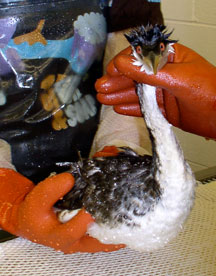Hello all-
Wow! What a busy week for wildlife issues and events – some good and some not so much. To keep this blog post at Kaiti-approved length (for those of you who are old like me and remember our former Volunteer Coordinator-turned-ecolawyer), here are the highlights:
Apr 20th = 3rd year anniversary of the Deepwater Horizon Spill. It’s hard to believe that it has been three years since that event rocked the oil spill world. Efforts are still underway to understand the impacts to the Gulf of Mexico from this blowout, with some info just now being released on marine mammal issues (see below). On the readiness side, the OWCN is finalizing a first draft of new and expanded national Oiled Marine Mammal Guidelines for NOAA-NMFS that will hopefully help address some of the key issues this spill raised.
Apr 21 = Oiled wildlife training for the International Association of Aquatic Animal Medicine (IAAAM) conference, hosted by The Marine Mammal Center. Christine, Nancy and I gave a day-long course to over 40 international marine animal professionals (mostly marine mammal vets, but several others of various ilk). The course was long on Powerpoints (cramming oil spill info on mammal and birds species over a short time period), but did include a great hands-on portion where TMMC allowed us to do “processing and intake” on four juvenile elephant seals. Overall, it was a great enthusiastic group – special thx to Frances Gulland and Tenaya Norris for organizing, as well as the entire TMMC vet/husbandry staff for pitching in during a very busy day!

Platform A Oil Spill (courtesy MSNBC)
Apr 22nd = Earth Day. In 1970, the concept of Earth Day was developed by Gaylord Nelson, US Senator from Wisconsin, after witnessing the effects of the 1969 Platform A blowout in Santa Barbara. He felt that if he could infuse that energy with an emerging public consciousness about air and water pollution, it would force environmental protection onto the national political agenda. Since that time, Earth Day has held a special place in our hearts within the oil spill community, as it led to the formation of the USEPA, the Clean Water Act, and the Oil Pollution Act of 1990 (OPA90). For more info on this event and its history, please visit http://www.earthday.org/earth-day-history-movement.
Apr 22nd – 25th = IAAAM Conference at Cavallo Point Lodge, Sausalito. This international meeting brought together more than 440 wildlife professionals from 25 countries to discuss issues and research findings pertinent to our marine species. The setting was gorgeous, the papers and posters fascinating, and the discussions and networking capabilities were thought-provoking and exciting. Especially relevant was presentations by Drs. Stephanie Venn-Watson and Cynthia Smith of the National Marine Mammal Foundation on health affects being seen in bottlenose dolphins from the coastal Louisiana region. Fascinating work that may assist us in better understanding the unusual mortality event that continues to rage there, and the possible effects that the DWH spill had on this species. More info on the conference can be found at http://www.iaaam.org.

Oiled little blue penguins (Courtesy Maritime NZ)
Apr 25th = World Penguin Day. To round out a crazy busy week, we took a day to appreciate and better understand the amazing animals that are penguins. As we are all aware, penguins are key animals for us to describe the horrific effects of oil on animals (as the Treasure and Oliva oil spills) as well as the significantly positive results that can be seen with effective and professional rehabilitation (as SANCCOB/IBRRC/IFAW and Massey University have shown). Further, these birds have led to significant research on the long-term effects of oiling on marine species and given us great data to base arguments on the merits of intervention after oil spills. Lastly (and something I did not know before), they can tell us a lot about our own personality types! If you haven’t yet done so, go take the Pew Charitable Trust Penguin Personality Quiz (as well as learn about the conservation efforts for “your” species). BTW – Adelie penguins rule!
OK, so much for “highlights”! I hope everyone has a great restful and oil-free weekend!
– Mike












You must be logged in to post a comment.